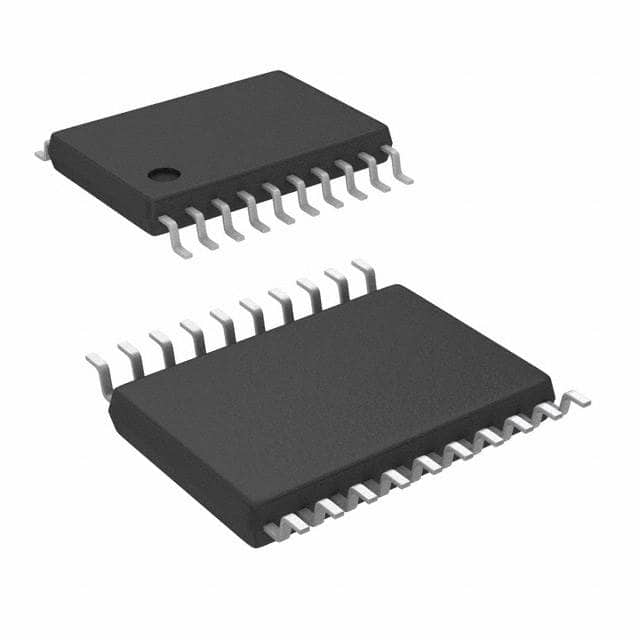Xem thông số kỹ thuật để biết chi tiết sản phẩm.

MC10EP56DTR2
Product Overview
- Category: Integrated Circuit (IC)
- Use: Signal transmission and processing
- Characteristics: High-speed, low-power, differential receiver
- Package: TSSOP-8
- Essence: The MC10EP56DTR2 is a high-performance differential receiver IC designed for use in various signal transmission and processing applications.
- Packaging/Quantity: Available in tape and reel packaging, with 2500 units per reel.
Specifications
- Supply Voltage: 3.0V to 5.5V
- Operating Temperature Range: -40°C to +85°C
- Input Voltage Range: -2.0V to VCC + 2.0V
- Propagation Delay: 200ps (typical)
- Output Skew: 20ps (typical)
- Input Resistance: 50Ω (differential)
- Output Current: ±100mA
Pin Configuration
The MC10EP56DTR2 has a total of 8 pins arranged as follows:
```
| | --|1 8|-- VCC --|2 7|-- Q --|3 6|-- /Q --|4 5|-- GND |_________| ```
Functional Features
- High-speed differential receiver with ECL (Emitter-Coupled Logic) inputs
- Compatible with various logic families such as PECL, LVPECL, and CML
- Wide input voltage range allows for flexible interfacing with different signal sources
- Low power consumption makes it suitable for battery-powered devices
- Differential inputs provide excellent noise immunity and common-mode rejection
Advantages and Disadvantages
Advantages: - High-speed operation enables reliable signal transmission in demanding applications - Wide input voltage range allows for versatile compatibility with different systems - Low power consumption helps to extend battery life in portable devices - Differential inputs provide robust noise immunity and signal integrity
Disadvantages: - Limited availability of alternative models from other manufacturers - Relatively small package size may require careful handling during assembly
Working Principles
The MC10EP56DTR2 operates based on the ECL logic family, which utilizes differential signaling to achieve high-speed and low-power performance. It receives differential input signals and converts them into single-ended outputs using internal amplifiers and comparators. The device is designed to operate within a specified supply voltage range and provides excellent noise immunity and signal integrity.
Application Field Plans
The MC10EP56DTR2 can be used in various applications that require high-speed signal transmission and processing. Some potential application fields include:
- Telecommunications: Used in high-speed data communication systems, such as optical networks and fiber-optic links.
- Test and Measurement: Employed in equipment for signal analysis, waveform generation, and data acquisition.
- Industrial Automation: Integrated into control systems for precise timing, synchronization, and data exchange.
- Automotive Electronics: Utilized in advanced driver assistance systems (ADAS) and vehicle communication networks.
- Medical Devices: Incorporated into medical imaging equipment, patient monitoring systems, and diagnostic instruments.
Alternative Models
While the MC10EP56DTR2 is a highly capable IC, there are alternative models available from other manufacturers that offer similar functionality. Some notable alternatives include:
- Texas Instruments SN65LVDS31: LVDS (Low-Voltage Differential Signaling) receiver with wide common-mode voltage range.
- ON Semiconductor MC100EP016A: High-speed ECL receiver with integrated input termination resistors.
- Analog Devices ADN4664: Differential receiver with programmable output voltage levels and integrated termination resistors.
These alternative models can be considered based on specific application requirements and availability in the market.
Word count: 511 words
Liệt kê 10 câu hỏi và câu trả lời thường gặp liên quan đến ứng dụng MC10EP56DTR2 trong giải pháp kỹ thuật
Sure! Here are 10 common questions and answers related to the application of MC10EP56DTR2 in technical solutions:
Q: What is MC10EP56DTR2? A: MC10EP56DTR2 is a high-speed differential receiver designed for use in various communication and data transmission systems.
Q: What is the operating voltage range of MC10EP56DTR2? A: The operating voltage range of MC10EP56DTR2 is typically between -4.2V and -5.7V.
Q: What is the maximum data rate supported by MC10EP56DTR2? A: MC10EP56DTR2 can support data rates up to 3.2 Gbps, making it suitable for high-speed applications.
Q: Can MC10EP56DTR2 be used in both single-ended and differential signaling applications? A: No, MC10EP56DTR2 is specifically designed for differential signaling applications and cannot be used with single-ended signals.
Q: What is the input voltage swing requirement for MC10EP56DTR2? A: The input voltage swing requirement for MC10EP56DTR2 is typically 200 mV.
Q: Does MC10EP56DTR2 have built-in termination resistors? A: No, MC10EP56DTR2 does not have built-in termination resistors. External termination resistors may be required depending on the application.
Q: What is the output voltage swing of MC10EP56DTR2? A: The output voltage swing of MC10EP56DTR2 is typically 800 mV.
Q: Can MC10EP56DTR2 operate in a wide temperature range? A: Yes, MC10EP56DTR2 is designed to operate in a wide temperature range, typically from -40°C to 85°C.
Q: What is the package type of MC10EP56DTR2? A: MC10EP56DTR2 is available in a 8-pin SOIC (Small Outline Integrated Circuit) package.
Q: Can MC10EP56DTR2 be used in high-speed networking applications? A: Yes, MC10EP56DTR2 is suitable for various high-speed networking applications, including Ethernet and fiber optic communication systems.
Please note that these answers are general and may vary depending on specific application requirements. It's always recommended to refer to the datasheet and consult with technical experts for accurate information.

